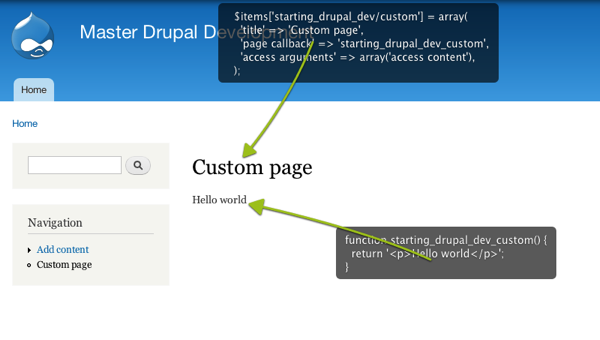In this tutorial you are going to learn how to create a new page programmatically by registering a path in a menu hook.
You will create the custom path by adding an implementation of hook_menu() and adding the first element of the $item array. We are going to keep it to the bare minimum at the moment, and build from there.
When you implement a hook, you create a new function and follow a specific pattern. The pattern is
You also need a comment, stating that you have implemented a hook.
You need to return an associative array defining the paths, title, call back function and access arguments.
You have registered path of starting_drupal_dev/custom in the array key. You have given it a title of “Custom page”, which will be used as a title when viewing the page and used as link text for the menu item. You have defined a callback function called starting_drupal_dev_custom(). And finally, you have provided access arguments of access content, so anyone with the necessary permission to access content will be able to view our page.
In order for the menu to be added to the menu registry, you need to clear the menu cache.
You can do this by going to Configuration and Performance and hitting Clear Cache, or you can run the following Drush command:
Now you need to add callback function, so that Drupal knows what to do when you visit the new path and what to return to the browser. So go ahead and add the following code:
Hello world
Now visit the page - http://yoursite.com/starting_drupal_dev/custom. You should see a page with a title of “Custom page” and “Hello world” printed.
Ok, we are getting somewhere. But you really should not return HTML markup directly from the callback function. We should use the Drupal's Render API. So let’s change the callback function to include a render element. A render element is an associative array containing properties that the theme system needs to render it as HTML.
Hello world
This is a very simple example of a render element, with just two properties, the type and markup. This might seem confusing and unnecessary, but it does add another layer of flexibility as it allows module developers and themers to alter the page content and layout before it is displayed to the user.
And that is it. You have successfully created a custom path and displayed a string.
This tutorial is part of the Starting Drupal Development course. If you would like to receive all of the lessons, please add your details in the box below. To scale the Drupal development learning curve faster, check out my book Master Drupal Development. It will help you master module development faster to become a fully fledged Drupal developer.hook_menu() and your module name is starting_drupal_dev, you need to create a function called starting_drupal_dev_menu(), as follows:
</p>
function starting_drupal_dev_menu() {
}
/**
* Implements hook_menu().
*/
function starting_drupal_dev_menu() {
}
/**
* Implements hook_menu().
*/
function starting_drupal_dev_menu() {
$items['starting_drupal_dev/custom'] = array(
'title' => 'Custom page',
'page callback' => 'starting_drupal_dev_custom',
'access arguments' => array('access content'),
);
return $items;
}
$ drush cc menu
/**
* Custom callback function.
*/
function starting_drupal_dev_custom() {
return '
/**
* Custom callback function.
*/
function starting_drupal_dev_custom() {
$content['raw_markup'] = array(
'#type' => 'markup',
'#markup' => '

